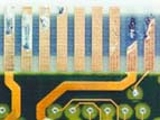Options for Gold Contact Rework
|

|
|
|
Examples of solder contaminated and damaged gold edge contacts.
|
When gold edge contacts become worn, damaged, or contaminated by solder, they must be repaired and replated or replaced.
Both procedures result in a high conformance level repair that is reliable and long lasting.
Sizing up the Options
Re-plating is a reliable yet complicated process requiring a considerable amount of setup, unique hazardous chemistry, and, in general, a high level of operator skill and training. Gold re-plating is the best choice when a significant volume of re-plating is needed to justify the setup when minor physical damage (chipping or scratches) exists and even when no physical damage is present on the contact.
Replacing the contact is faster and simpler, lacking the setup and chemistry of re-plating, but should only be used for low volumes - five or six contacts, or less, per board. If damage to the base material of the board exists, the base material must be repaired before the contacts can be repaired or replaced.
Contact Replacement
The contact replacement procedure involves replacing a damaged edge contact with a new, dry-film, adhesive-backed gold plated edge contact. The new edge contact is hot bonded to the circuit board surface using a bonding iron or bonding press. The board surface must be completely flat and undamaged.

|
|
|
Image shows a gold contact replaced using the Film Adhesive Method.
|
The replacement edge contacts are fabricated from copper foil and have a dry-film adhesive coating on the back. Edge contacts are available in hundreds of sizes and shapes (custom, too) and are generally supplied plated with nickel or gold.
To replace a contact, remove the defective edge contact and a short length of the connecting circuit - heating the area with a soldering iron to make the old contact easier to remove. The area should be cleaned after old epoxy residue and contamination are scraped from the board surface. Flux and tin the connection area with a small amount of solder and a soldering iron.
Select a new gold contact, trim it from the contact foil sheet, and put it in place. The circuit overlap should be a minimum of twice the circuit width. Scrape the adhesive backing from the overlap connection area. Hold in place with high-temperature tape and then hot-bond the new contact with a small amount of flux solder the overlap area to form a lap-soldered connection.
Contact Re-Plating
Gold edge contacts may need re-plating if contaminated with solder. Such contamination requires that the operator strip away the solder completely by mechanical and chemical means and then re-plate the contacts.

|
|
|
Image shows gold contacts being replated using the Plating Method.
|
Since the procedure involves stripping and plating chemicals, attentive care must be taken - and proper handling procedures followed to protect the health and safety of workers. The plating solutions are hazardous chemical solutions and must be disposed of properly. For example, the gold plating solution contains potassium gold cyanide, nickel-plating solution contains nickel sulfate, and electro-cleaning solution contains sodium hydroxide.
First, clean the circuit board assembly. Then, apply plating tape to the problem area to protect adjacent areas and components from the plating and stripping solutions. Next, flow solder over the entire area of any contaminated contacts. Then remove the bulk of the solder using solder braid and apply a stripping solution that will act upon the area uniformly.
Once the solder has been stripped away and the surface adequately rinsed and prepared, the contacts may be re-plated. This electroplating process uses a DC power supply. Connect one lead to the connector edge to be plated. Form a conductive bus to all contacts that need plating. A reliable bus connection is the most crucial step in successful plating.
Connect the second lead to the plating probe. The plating probe has an anode fastened to the tip wrapped in absorbent material. Dip the anode into a high-speed proprietary plating solution. Swab the saturated anode across the circuit board connector edge contacts - the metal contained in the solution is plated wherever electrical contact is made.
When finished, rinse the area with water. Remove and discard all plating tape and thoroughly rinse the area with water again. Dry the area using wipes. Remove the wire or conductive paint used to bus the contacts, protecting the contacts from further contamination by masking them with high-temperature tape while removing the bus connection.
For precise thickness requirements, the final thickness of the plating should be verified with proper measuring equipment. The plating bond may also be checked by performing a peel test using peel-testing tape. Lastly, visually examine the rework area for color and luster.
Conclusion
Ensure that all technicians involved in the plating process wear protective eyewear, gloves, and clothing. Follow the step-by-step procedure for plating carefully - this includes making the cathode and cable connections and setting the correct output current on the power supply and voltage/time settings according to the equipment manufacturer's specifications.
Whether replacing or re-plating gold edge contacts, be precise, safe, and methodical. Follow the procedural steps religiously.
The results are reliable connections and a new life for repaired boards.
Several members of the Circuit Technology Center team contributed to this feature story.
|
|
|
|
|